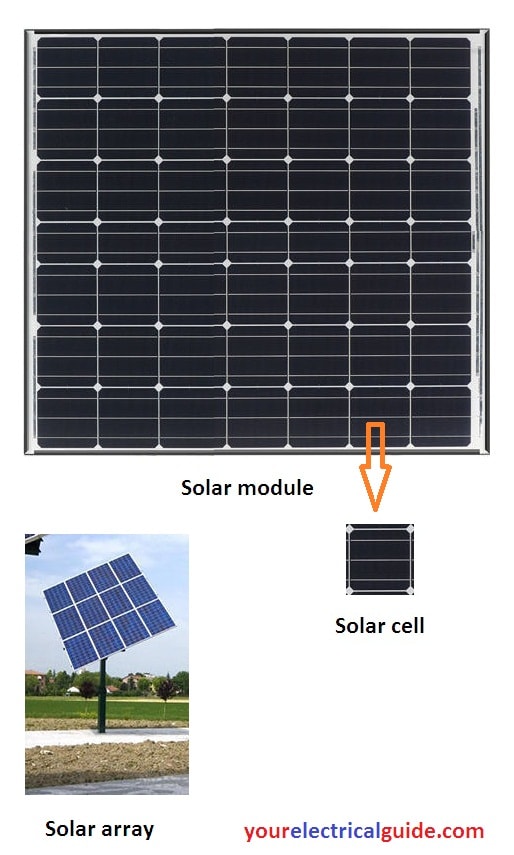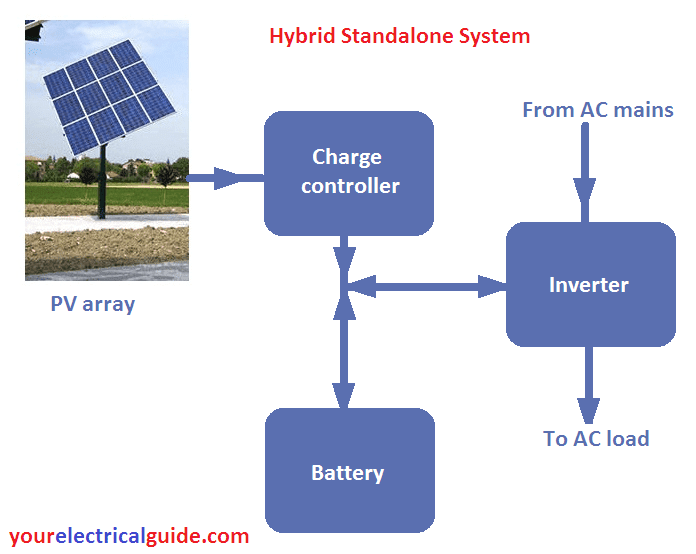Hi friends, in this article I am going to discuss about solar panel working principle and hope you will like my effort.
In the solar photovoltaic system, solar energy is directly converted to electric power. This makes the system far more convenient and compact compared to thermal methods of solar energy conversion.
The solar cell technology is the fastest growing power generating technology in the world. It is due to fact that the solar cells with conversion efficiency of more than 40% are becoming available.
Solar Panel Working Principle
A photovoltaic cell is also called a solar cell. It is a semiconductor device which converts sunlight into DC power using the photoelectric effect. Practically, all solar cells are photodiodes made of semiconductor material like silicon. A solar cell works in three steps:
- Photons in the sunlight hit the solar cell and are absorbed by the semiconductor material.
- Negatively-charged electrons are knocked off from their atoms and start flowing in the same direction to produce electric current.
- A typical silicon solar cell can produce up to 0.5 V and current up to 6 A. Thus, its maximum power is 3 W.
Since the output of a single solar cell is very small, a large number of solar cells are interconnected to form a solar module, combination of solar modules is called panel and combination of panels is called solar array. It is done to get the required power output from a PV system.

When the solar cells are connected in series their voltage increases as much as the number of cells connected in series. But the current remains the same.
When cells are connected in parallel, voltage remains constant, same as that of one cell but current gets multiplied. The cells, modules or panels can be connected in parallel only if their voltages are the same. Main components of a solar PV system are as under:
Blocking Diodes
The SPV arrays are connected to the battery. During sunshine hours the panels generate electricity which charges the battery. But when there is no sunshine or during the night the current will try to flow in the reverse direction i.e. from the battery to the arrays. This can damage the arrays. So to avoid this reverse flow of current, blocking diodes are used.
Voltage Regulator
The voltage output from PV panels varies according to the intensity of sunlight. This would lead to the fluctuation of load current. The voltage regulators will ensure that the voltage fluctuations are kept within the prescribed limit.
Inverter
Since power produced by a PV array is DC, an inverter is used to convert it into AC power so that we can utilize it easily. The inverter unit installed with different protection devices ensures the safety of the system and performs automatic changeover of load and available power sources.
Storage Batteries
These are used storage of solar energy. They are the most vital components of the Solar PV system. The success of a Solar PV system depends upon battery storage system very much.
Battery Controllers
These are devices to ensure that the charging of batteries is done in a proper way. They control charging current and protect the battery from overcharging. This is done by constantly monitoring the battery current, voltage and temperature.
Types of Solar Photovoltaic System
According to the method of utilization, there can be two configurations:
- Stand-alone system
- Grid-connected system
Stand-alone System
In this system, power is supplied to a load without the use of any common grid or connection to any other system and operates autonomously and independently. It is used for backup power where connecting to the grid is very costly. It can be used to power DC loads, also the AC loads using an inverter.
There are different types of standalone systems. But the hybrid stand-alone system is most commonly used.

In a hybrid standalone system, one or more sources in addition to the PV panels are used. Sources like generators, fuel cells, AC mains etc. may be used in conjunction with PV arrays. Thus dependence on any single source is reduced. This also reduces battery storage capacity and size of PV arrays.
Grid-connected System
In this system, the power generated by the PV array is given to grid or to the AC loads directly. When power generation exceeds the requirement of the loads, it is supplied to a commercial grid. Thus the system becomes a part of a large network. In this system, when power produced by the PV array exceeds the local load requirement, is supplied to the grid. An energy meter is used to monitor the supplied energy.
Thanks for reading about solar panel working principle.
Related Posts
- Solar Energy Systems
- Solar Cell | Photovoltaic Cell
- Solar Concentrator PV Systems
- 3D Solar Cells
- 3D Solar Cell Systems
- Electrical Specifications of PV Modules
- Standard Test Conditions for PV Modules
- PV Arry Charge Controllers
- Sizing a Grid-Direct PV System
- Sizing a Battery-Based PV System
- Site Survey for PV Installation
- Understanding Solar Radiation for PV Installlation
- Concentrating Solar Collectors
- Solar Energy Systems
- Solar Panel Working Principle